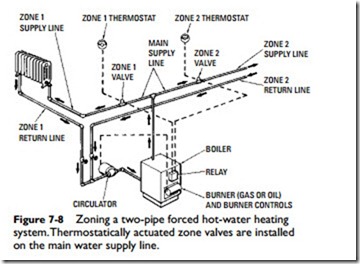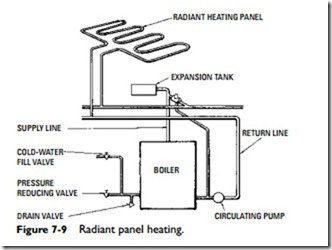Combination Pipe Systems
Sometimes two or three different pipe arrangements will be combined in a single heating system. For example, it is not unusual to find a two-pipe, reverse-return system combined with a series- loop system. Combination pipe systems are usually found in commercial or industrial buildings and are fitted to specific design needs.
Zoning a Two-Pipe System
Balancing problems for two-pipe hydronic heating systems in larger houses and buildings can be solved by splitting the existing system into two or more separate zones independently controlled by their own thermostats. This can be accomplished by installing a two- position valve in the hot-water supply line. The valve is actuated by its own thermostat (Figure 7-8).
Radiant Panel Heating
Forced hot water can also be used in a radiant panel heating system (Figure 7-9). In this heating system, no radiators or convectors are used. The hot water circulates through pipes concealed in the floor, ceiling, or walls, which function as heat-emitting surfaces. Radiant baseboard systems are also used. The principles of radiant heating are described in greater detail in Chapter 1 of Volume 2, “Radiant Heating.”
Other Applications
It is possible to use the boiler of a hydronic heating system to sup- ply heat for such purposes as melting snow and ice on walks and driveways, heating a swimming pool, or heating a patio. Separate circuits are created for each of these functions and are controlled by
their own thermostats. They are designed to tap into the main heating circuit from which they receive their supply of hot water. If win- ter temperatures stay at or below freezing for long periods of time, the water in an outdoor circuit must be protected with an antifreezing additive. See Chapter 5, “Heating Swimming Pools” in Volume 3 for detailed coverage of this subject.

